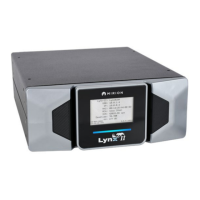Lynx II Setup for Administrators and Users
Lynx II DSA User's Manual – 7096089 67
• Proceed with installation and setup as required by your site. For example,
− Setting the Lynx II’s network settings to conform to your network requirements,
such as enabling DHCP for dynamic address assignments,
− Establishing a security password and enabling Login to restrict access to the
Lynx II if required. “Login required” by default is disabled.
− Enabling or Disabling UPnP messaging to meet your network requirements
• Refer to Communications Setup starting on page 153 for a summary of the setup
details concerning UPnP and other communication parameters to customize your
Lynx II installation.
Communication Interfaces
To use any of Lynx II's communications interfaces, connect the supplied cable between
the Lynx II and another device, such as a hub or the host computer. The Communications
Setup appendix starting on page 153 describes the initial setup and basic operation of each
of these interfaces.
Ethernet
Lynx II supports 10/100/1000 Base-T Ethernet for connecting to an existing Ethernet
network using an Ethernet patch cable (color varies).
One 3 m (10 ft) CAT 5e Ethernet patch cable is supplied.
USB OTG
Micro USB OTG is for connecting the Lynx II as a Device to a USB hub or directly to a
host computer. One 1.8 m (6 ft) USB cable is supplied.
USB setup instructions are found in Setting Up a USB Connection on page 162.
Lynx II Setup for Administrators and Users
This section provides instructions on how to connect your Lynx II to the Lynx II Web
Client Interface. The operation of the Lynx II Web Client application will be covered in
Web-Based Operations on page 70, additional information on using the application and
algorithms used by the application can be found in Non-parameterized ROI on page 192.
If you have a single Lynx II connected to a dedicated network whose addresses are
managed by you, then the factory default settings could suffice. More often than not, it is
typically the case that the Lynx II will be connected to a network with other devices, in
which case the address of each may be dynamically assigned by the network’s DHCP
server or must be manually assigned to eliminate address contentions.
Each site’s network requirements are unique. To connect your Lynx II to your network
typically requires changing the Lynx II’s settings to match your network’s requirements.
To make such changes, you will need to first connect to the Lynx II using Ethernet or
USB.

